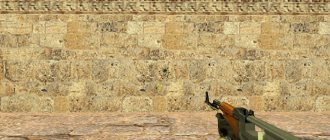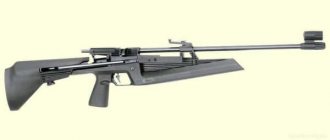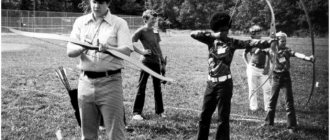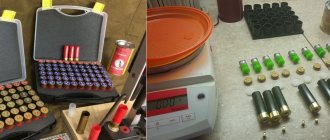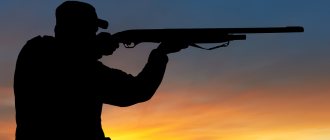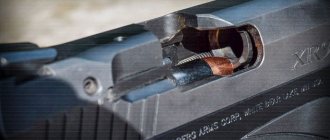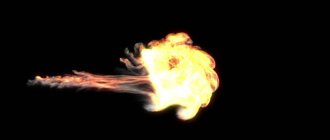Selecting weapons for duck hunting
Ducks are considered cautious and vigilant birds, so it is not advisable to approach them closer than 45–50 meters during duck hunting. You can simply scare them away. They have to wait for prey at a distance.
Duck hunting rifles do not have their own category. You can successfully shoot a duck with any hunting weapon if you choose the right shot. The gun consists of a barrel with specially located holes for the choke or choke constriction.
For duck hunting, the gun must meet the following requirements:
- it was convenient for shooting at a distance;
- increased combat accuracy;
- large capacity of shot in the projectile;
- It is desirable that there is a noticeable weight of the weapon.
The longer the barrel of a gun, the better it ensures the accuracy of the shot when fired. This principle is necessary for long-distance shooting when hunting game in ambush. Hunters prefer multi-shot weapons or use double-barreled shotguns with an ejector mechanism for duck hunting, which can be quickly reloaded if necessary.
When choosing equipment, you need to consider what time the hunt will take place:
- In summer, preference is given to mobile models that can be easily moved (weight no more than 3.5 kg, and trunk length about 75 cm). The following models are suitable: TOZ-25, TOZ-34, MR-94, IZH-27. You can also consider modern versions of the M-153 and M-155 for hunting in the summer.
- In the autumn, hunting is considered calm; ducks are waited for in ambush and lured there with a variety of baits. By autumn, the bird gains additional fat, so more penetrating force is required, and the accuracy of the shot must be wider. When the ducks have taken the bait, you need to hit as many targets as possible with one clear shot.
Even if you plan to shoot several carcasses at once, you need to aim at one target.
The following models are suitable: with a longer barrel up to 80 cm, it is advisable to use double-barreled shotguns, but whether it will have triggers or not, horizontal or vertical - this is up to each hunter to choose a convenient shotgun for himself. Attention should be paid to the selection of cartridges.
Shot for hunting
A very pressing question arises for beginners regarding which shot should be chosen for hunting. No hunter will give an exact answer to this question, just like with a gun, you need to choose the cartridges for yourself. The majority of hunters tend to use shot from No. 4 to No. 7. So which shot number should you choose for a duck? This depends on the time of the hunt and the size of the intended game.
It is believed that No. 5 is duck shot. Many hunters use it in the spring, but it is not considered suitable for every bird. For example, for small teal you can use No. 7. Some hunters are inclined to use No. 4 shot for hunting at different distances. So when choosing a fraction, you need to try in practice which number is best.
The main thing here is to observe the ratio of gunpowder and shot. If the hitch is chosen incorrectly, then there is a possibility of wounded animals that will fly away from the hunter.
Skeet Thrower - Skeet Launcher
The plates are served using a machine controlled by an operator-instructor. The operator holds in his hands a special remote control with a button. You press a button and a plate flies out of the machine. The machine runs on a battery, and the plates are charged in a stack. Everything seems simple.
As a rule, the machine is configured to launch plates at a fixed angle. On the field, the cars are placed in such a way that the plates fly both from the shooter (hijacked target) and towards him (counter target). While we were shooting, we tried to hit not only the stolen targets, but also the targets that were flying out from the right and left.
Features of fractions in spring
Depending on the time of hunting, you need to choose a different shot number for the bird. This is necessary for more accurate destruction of the carcass so that no wounded animals remain.
| View | Fraction number |
| Wigeon, red-headed and white-eyed pochard, gadwall, mallard | 4 and 5 |
| Red duck, blue duck | 4 |
| Teal, lutok, shoveler | 6 |
However, it is worth remembering that spring hunting is a rare occurrence and is not permitted in all places and regions.
Features of fractions in autumn
By the autumn season, ducks have time to gain weight, so the shot should be selected based on new factors. After all, the correct choice of shot directly affects the outcome of the hunt.
| View | Fraction number |
| Wigeon, red-headed and white-eyed pochard, gadwall, mallard | 4 and 3 |
| Red duck, blue duck | 4 and 5 |
| Teal, lutok, shoveler | 6 and 5 |
Calculates leads
If a beginner is trying his hand at hunting, then he needs to figure out how to calculate the lead when shooting at a duck and other flying birds. The calculation is simple: the flight speed is multiplied by the speed of the shot. However, this does not mean that you will dream of calculating these indicators during a hunt. You need to keep this data in your head and make decisions quickly. The data from the table will help for the calculation.
| Bird species | Flight speed, m/s |
| Capercaillie and black grouse | 15–18 |
| Teal | 18–35 |
| Duck | 21–27 |
| Mallard | 18–27 |
| Partridge | 13–14 |
The necessary data for calculating the lead is also considered to be the flight speed of the shot; depending on the distance to the duck, the speed changes.
| Fraction number | Speed fractions m/s in depending on distance to target | |||
| 20 m | 30 m | 40 m | 50 m | |
| №1 | 0,06 | 0,10 | 0,14 | 0,18 |
| №3 | 0,06 | 0,10 | 0,14 | 0,19 |
| №5 | 0,06 | 0,10 | 0,15 | 0,20 |
| №7 | 0,07 | 0,11 | 0,16 | 0,22 |
| №9 | 0,07 | 0,11 | 0,17 | 0,24 |
Using these data, calculating the lead when shooting at a duck is quite simple, just remember that the speed of a frightened game may differ from the standard flight.
Types of cartridges
While there is a wide range of cartridges to choose from, there is no one-size-fits-all for running deer. At the same time, the most popular cartridges for roe deer among hunters are 9.3x72 and 8x57 shells.
Read also: Side Türkiye attractions
Cartridges 9.3×72
Practice has shown that the main factor in a successful roe deer hunt is the use of high-velocity bullets . So, from a distance of two hundred meters, a .222 caliber bullet can cause minimal damage to an animal carcass. Good penetration is characteristic of the .243 Winchester cartridge. When using it, there are practically no hematomas. A 6 mm cartridge made on the 5.6x39 base is also suitable.
.222 caliber bullets
Good muzzle velocity is also present in the .22-250 Remington cartridges. The formation of hematomas upon contact is not observed. However, this brand is very rarely used by Russian hunters.
.22-250 Remington cartridges
The 6x70 cartridge also has good muzzle velocity. It is 800 m/s. But very often bruises form when firing this projectile.
How to aim at a stationary target
How to properly aim at a duck while stationary (on water or land). Hunting such ducks is not particularly difficult. Take into account some moments when a duck hits the sight. If she is in the water, then you should aim at the point where her body and the body of water come into contact. It must be remembered that 1/3 of the carcass is in the water at this time; due to the small area to hit, the shot must be accurate.
However, it is not easy to hit such a target, since in this position they are smaller than flying ducks. They have a thicker layer of plumage on their chest (in a sitting position), so it is not advisable to aim there. It is recommended to aim for the head, side or back.
If duck hunting is on the shore, and they are calmly walking along the shore or standing, then it is better to aim at the center of the carcass. However, you should not expect to hit a sitting duck from a long distance; such a target will most likely escape.
Rules
Standard rules that do not contain anything new. The points:
- Wear headphones
- Don't go beyond the barrier
- Don't aim at people
- After finishing shooting, turn the flag all the way to the right, cut the barrel in half and pass it on to the next one,
- The launch of the plate occurs on the command “Give!”
If we are talking about competitions, then the main idea is this: 5 shots from different five numbers on the first day, and 20 shots from 5 numbers on the second day. And this is the minimum - 125 shots.
The subtleties of shooting while a duck is in flight
Hunting a duck in flight is different from hunting a stationary target. The hunter has to calculate many factors that influence an accurate hit. So how do you properly aim at a duck in flight?
The first thing you need to understand is the principle of the totality of actions. You need to shoot ahead, since the shot takes time to reach the target, and the duck continues to move at this time.
There are main types of duck shooting:
- counter;
- stolen;
- lateral;
- semi-hijacked.
It is believed that it is best to shoot the bird halfway, as the resistance of the feathers has less effect on the shot. However, if the hunt takes place in the summer, after molting, then the bullet will not encounter strong resistance.
Every hunting trip is not complete without shooting at a duck. At first glance, it seems that hunting for a moving target at the human level and shooting a duck in flight is somehow not very difficult. However, this opinion is erroneous; often the duck avoids the shot. In this case, attention should be paid to increasing the distance, due to which the magnitude of the speed drop changes. Basically, the flight speed of a duck is 15 m/s. However, the data is inaccurate, since a duck can increase it from fright.
But the accuracy of the shot is affected not only by the speed at which the duck moves away, but also by the location of the bird. By shooting at the tail, the area affected by the duck is insignificant, and the wounded animal can escape.
Despite the difficulties in shooting, beginners still have a better chance of hitting a retreating bird than hitting a side target. This method of shooting at theft is considered ideal. Less than ideal conditions predominate in the total number of shots fired. Then the hunter has to take decisive action in a short time to ensure that the shot is successful.
Plates
Bright red plates with the inscription LIPETSK, which scatter when hit. As I wrote above, the plates are made of ceramics (which is the same clay, only after firing). They weigh a little, 50 grams each, and fly 30 meters, launched by a special machine. Initially, the machines are configured in such a way that the trajectory of the plate corresponds to a parabolic one.
Main shooting points
To make hits accurate, you need to aim at a flying duck, as the simple rules say:
- If the duck moves away from the hunter opposite the shoulders, then you need to aim straight at it.
- If she flies below shoulder level, then we select a target in front of her.
- When a bird flies upward, you need to aim as if covering it with the muzzle over it. The hunter's body moves with the target, only after the shot does the movement stop.
- The bird moves forward over the hunter. The sight is aimed under the bird, slightly ahead of it.
- The duck flies high towards the hunter. The sight is taken slightly in front of the duck, covering it with the barrel.
- When the duck heads sideways and gains altitude, the sight should be aimed above the bird and slightly ahead of it. With this option, double anticipation is necessary.
- When a duck sits down, the shot point is located under the duck in advance.
Hunting is a very exciting activity, but you can’t just go hunting; you need to understand the simple principles of how to properly aim at a duck, track and wait for it, and be able to choose the right weapon and cartridges. By following all the rules together, you can not only enjoy the hunt, but also get the long-awaited trophy.

